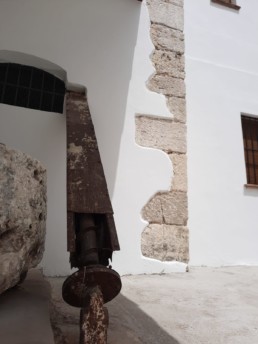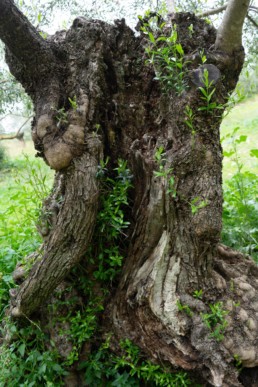Hacienda Molino Nuevo
A place with history
Inhabited since prehistoric times, the region was used for agricultural exploitation since Roman times.
The Islamic period, which lasted in Algodonales until 1484, transformed the area, which began to be irrigated by various water pipes.
With this technological leap, a central place is given to the cultivation of olive groves and cotton.
The latter was so important during the Muslim era that it is what gives the town of Algodonales its name.
Thanks to Islamic expertise, fountains were built such as the current Cristóbal Gómez fountain,
located almost a kilometer away from the old mill, and hydraulic channels to supply it.
The farm has been called Molino Nuevo since the 18th century,
when an older mill was rebuilt. The oil mill, which is undergoing rehabilitation,
contains all the characteristic elements of the oil industry, endless screw, stone,
hydraulic presses, mixer, drums, jars, etc.

The Hacienda Molino Nuevo suffered, like other buildings in the area, the consequences of the Napoleonic invasion of Spain, between 1810 and 1812. The Hacienda is on the route that served as an advance for the French troops following the Guadalete River. The farmhouse lost, among other things, the original railings. In the second half of the 18th century the farmhouse was rebuilt and the activity continues to this day. At the beginning of the 21st century, the family estate, transferred from mother to daughter for at least four generations, continues to be dedicated to olive cultivation, in integrated production, without the use of pesticides. The love that the owner has for this farm, in addition to the memories of her childhood, where she spent her vacations, make the family decide to rehabilitate the farmhouse and dedicate it to rural accommodation, so that the mild temperature, the long views and the colorful environment of the area, can be shared with the world. It is also the wish of the family to collaborate so that Algodonales, the land from which they come, continues to grow as a benchmark for tourism in Andalusia.
In the olive grove of the new mill, a reflection of a centuries-old culture, a large number of respectable olive trees, manzanillo trees and thrush trees survive in a display of longevity, which were in their early days wild olive trees and escambrones of the old oak forest. Its origin can be traced back at least to the end of the 18th century.

